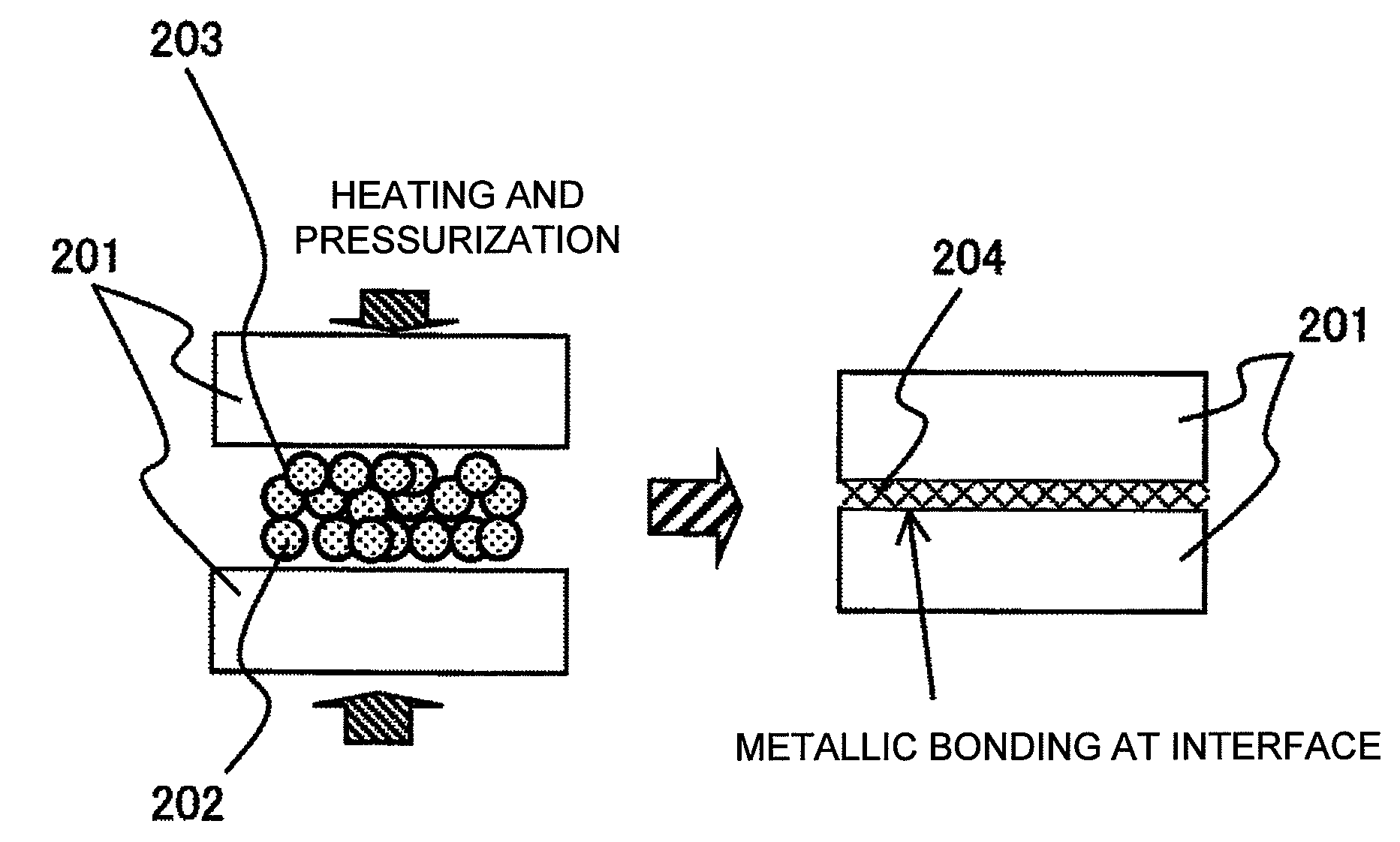Bonding method and bonding material using metal particle
a metal particle and bonding method technology, applied in the field of bonding materials, can solve the problems of insufficient heat dissipation and bonding reliability of a method for achieving metallic bonding at an interface, no material to replace high-temperature solder, and difficult to completely remove the protective film
- Summary
- Abstract
- Description
- Claims
- Application Information
AI Technical Summary
Benefits of technology
Problems solved by technology
Method used
Image
Examples
example 1
[0079]In Example 1, silver oxide (Ag2O) particles having an average particle diameter of about 2 μm were used, and myristyl alcohol (made by Wako Pure Chemical Industries, Ltd.) was used as an organic substance serving as a reducing agent. FIG. 1 shows the result of thermogravimetric measurement of myristyl alcohol. The thermogravimetric measurement was performed using a TG / DTA6200 made by Seiko Instruments Inc. At this time, the measurement was performed at a rate of temperature rise of 10° C. / min in the atmosphere. The result shows that the rate of weight loss versus temperature of myristyl alcohol at 244° C. was 99% or more. Myristyl alcohol and silver oxide (Ag2O) particles were then mixed such that the mixing ratio was 1:4 by weight. Actually, a bonding material was produced using 0.8 g of silver oxide (Ag2O) and 0.2 g of myristyl alcohol. Since myristyl alcohol is solid at room temperature, the myristyl alcohol was mixed with particles of the silver oxide (Ag2O) for 10 minutes...
example 2
[0085]In Example 2, bonding was performed using each of a bonding material (bonding material ) formed by mixing silver carbonate particles (made by Wako Pure Chemical Industries, Ltd.) having an average particle diameter of about 1 μm and myristyl alcohol in the weight ratio of 4:1, a bonding material (bonding material ) formed by mixing silver acetate particles (made by Wako Pure Chemical Industries, Ltd.) and myristyl alcohol in the weight ratio of 4:1, and a bonding material (bonding material ) formed by mixing silver oxide particles having an average particle diameter of about 2 μm and silver acetate particles (made by Wako Pure Chemical Industries, Ltd.) in the weight ratio of 4:1, and shear strength measurement was performed. Each pair of components was mixed using a mortar. Of test pieces for bonding, the upper one was 5 mm in diameter and was 2 mm in thickness while the lower one was 10 mm in diameter and was 5 mm in thickness. The front surface of the lower test piece was p...
example 3
[0091]FIGS. 6(A) and 6(B) are views showing the structure of a non-insulated semiconductor apparatus serving as an example of the present invention. FIG. 6(A) is a top view, and FIG. 6(B) is a sectional view of FIG. 6(A) taken along line A-A′. Semiconductor devices (MOSFET) 301 are mounted on a ceramic insulating substrate 302, and the ceramic insulating substrate 302 is mounted on a base material 303. After that, an epoxy resin case 304, bonding wires 305, and an epoxy resin lid 306 are provided, and the epoxy resin case 304 is filled with silicone gel resin 307. The ceramic insulating substrate 302 on the base material 303 is bonded through a bonding layer 308 composed of a paste material formed by dispersing silver oxide (Ag2O) particles having an average particle diameter of about 2 μm and myristyl alcohol in the weight ratio of 4:1 in a toluene solution. Eight MOSFET devices 301 made of Si are bonded to copper plates 302a of the ceramic insulating substrate 302 through bonding ...
PUM
| Property | Measurement | Unit |
|---|---|---|
| particle diameter | aaaaa | aaaaa |
| particle diameter | aaaaa | aaaaa |
| particle diameter | aaaaa | aaaaa |
Abstract
Description
Claims
Application Information
 Login to View More
Login to View More - R&D
- Intellectual Property
- Life Sciences
- Materials
- Tech Scout
- Unparalleled Data Quality
- Higher Quality Content
- 60% Fewer Hallucinations
Browse by: Latest US Patents, China's latest patents, Technical Efficacy Thesaurus, Application Domain, Technology Topic, Popular Technical Reports.
© 2025 PatSnap. All rights reserved.Legal|Privacy policy|Modern Slavery Act Transparency Statement|Sitemap|About US| Contact US: help@patsnap.com



